The Complicated Life of an Endangered Butterfly
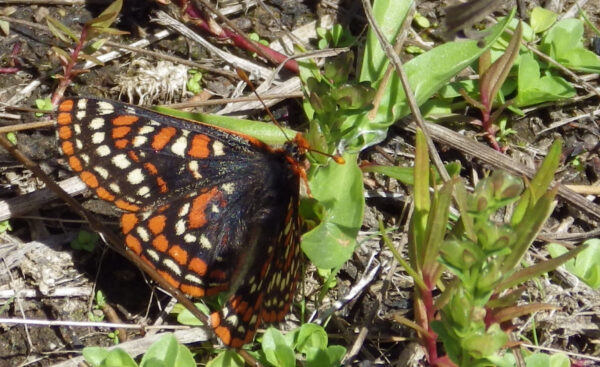
Taylor’s Checkerspot laying eggs. Chris Junck photo.
It’s too early to tell if the cooperative efforts to re-establish a population of the endangered Taylor’s Checkerspot butterfly on Hornby Island and to improve conditions for them on Denman Island are starting to pay off. The lifecycle of the rare butterfly is complex and the tiny creatures may encounter many perils and challenges at each developmental stage.
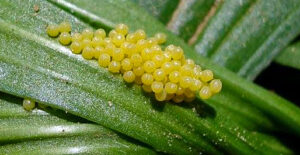
Taylor’s Checkerspot eggs on ribwort plantain. Jennifer Heron photo.
The adult butterfly stage only lasts for one to four weeks. When they emerge from their pupae form in May to mid-June, female Taylor’s Checkerspot butterflies need to find nectar from flowers for food, locate and mate with at least one of the few available males, and then deposit masses of golden eggs on suitable host plants.

Marsh speedwell. Chris Junck photo.
In BC, these are usually speedwells (American speedwell, thyme-leaved speedwell, marsh speedwell) or plantains (ribwort plantain, common plantain), but may also include harsh paintbrush, blue-eyed Mary, or other plants.
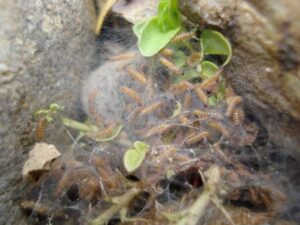
Larval web. Jennifer Heron photo.
Larvae (caterpillars) hatch from the eggs within a few days to two weeks and immediately spin protective web nets around the host plants.
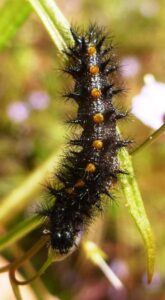
Instar 4 larvae eating marsh speedwell. Peter Karsten photo.
After eating their host plants, caterpillars disperse and search for more food. Caterpillars must ingest enough nutrients to grow and molt through four or five stages (instars) before food plants dry up during the summer.
If sufficient nutrients are consumed by mid-July, the larvae develop into their overwintering (diapause) stage. They look for a place where they can hopefully safely spend the next seven months, before emerging in early spring to start the cycle over again. Unless conditions aren’t suitable. If that happens, Taylor’s Checkerspot diapause larvae can remain in the delayed development stage until the following year.
Taylor’s Checkerspots may face many threats to survival at each stage of their lifecycle – extreme weather, insufficient suitable habitat or food, parasites, and predation. The eggs, larvae, and their food and protective cover plants are especially vulnerable to trampling by people and pets. The public can reduce this threat by treading carefully while staying on marked trails in Helliwell and North Denman provincial parks, or other areas where the butterflies may occur. Dogs must be on a leash according to provincial park regulations. If you see a Taylor’s Checkerspot caterpillar, take a photo and email it to Taylors.Checkerspot@gov.bc.ca.
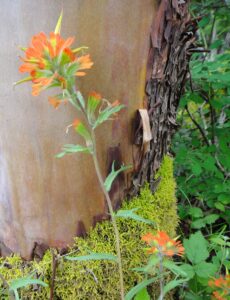
Harsh paintbrush. Chris Junck photo.
“We’re cautiously optimistic that our combined efforts will eventually pay off and these beautiful butterflies will survive in Canada”, said Jennifer Heron, Chair of the Taylor’s Checkerspot Butterfly Recovery Project Team and invertebrate conservation specialist for the B.C. Ministry of Environment and Climate Change Strategy. The recovery project is a collaborative initiative to restore Taylor’s Checkerspot populations in British Columbia through habitat enhancement, captive butterfly rearing and release, monitoring, public outreach, and other activities. The project team includes representatives from BC Parks, Denman Conservancy Association, Garry Oak Ecosystems Recovery Team, Greater Vancouver Zoo, Mosaic Forests, Wildlife Preservation Canada, consultants, and others. There has also been a lot of local assistance from Denman and Hornby volunteers, Helliwell Park neighbours in High Salal Ranch Strata, Conservancy Hornby Island, the Hornby Island Natural History Centre, and the Denman and Hornby Island Provincial Parks Committees.
The recovery project has benefited from funding generated by the BC Parks License Plate Program, the Environment Canada Habitat Stewardship Fund and the Habitat Conservation Trust Foundation.